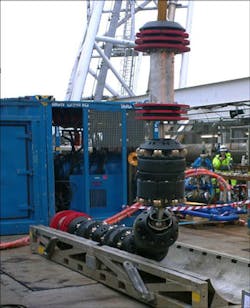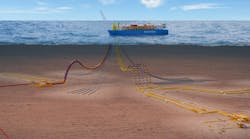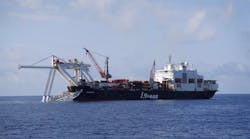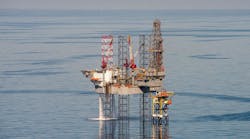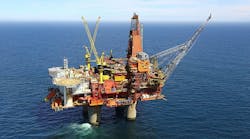Offshore staff
STAVANGER, Norway – Statoil has completed an inline isolation to facilitate the tie-in of its recently onstream Valemon platform to its Huldra-Heimdal pipeline in the Norwegian North Sea.
The company selectedT.D. Williamson (TDW) SmartPlug technology to safely isolate the line for 89 days during the operation.
Since 2001, gas and condensate produced from the Huldra platform was shipped to the Heimdal Gas Center through a 150-km (93-mi) 22-in. wet gas pipeline. To bring the Valemon platform online, Statoil decided to lay a new 27-km (16-mi) line tying in Valemon to the existing Huldra-Heimdal pipeline.
The SmartPlug isolation method provided a double block and monitor isolation to prevent flooding during the tie-in operation.
“The DNV GL-certified method allowed production from Huldra to continue for an additional five months,” said Atle Halvorsen, TDW project manager. The line was isolated for 89 days at an average isolation pressure of 84 bar (1,218 psi) and hydrotested at 174 bar (2,523 psi).
Additionally, the isolation made use of global system for mobile communications (GSM) monitoring. Benefits to Statoil, according to TDW, included:
- Reliable, real-time, round-the-clock monitoring from TDW’s Stavanger control center
- Elimination of on-site monitoring personnel and associated platform crew
- Reduced risk and cost associated with on-site personnel.
The SmartPlug tool and commissioning pigs were fitted with SmartTrack transponders that allowed monitoring via a range of communication setups, including cabled, acoustic, radio link, and GSM-based logging. The crew monitored the SmartPlug tool every hour during the tie-in program and also when the pipeline was hydrotested.
Six different measurements were taken: the high pressure side of the tool (HP), low pressure side (LP), annulus pressure (AP) between the two isolation plug modules, internal pipeline temperature (Internal), outside temperature (OT), and remote transceiver temperature (RTT) – which monitors the temperature on the seabed.
04/28/2015
